1. Getting to school
I lived on Sparken Hill, Worksop with my Aunt and Uncle while
at Retford Grammar. This meant walking about 1,000 yards to
the bus station to catch the Retford bus, usually a double decker
from Sheffield.
Most of the kids went upstairs, where you met your friends, imitated
last nights Goon-show or tried to do last minute home work. In a 40
minute, 7 mile trip, we passed Manton pit, under the railway, across the
A1 at Ranby, past the Army Camp, past the Church being built
near the River Idle, stopped at the High School to let the girls off,
then de-bussed at Albert Road and walked in a crowd to the School
in London Road about 8.40. It was an all-male school, except for the
secretary and a nurse.
2. School train
More pupils travelled by train from Worksop to Retford than bus.
It left Worksop at 0810 and reached Retford at 0823. Two non-corridor
coaches were added for the use of the boys, the girls had to use the
normal corridor coaches, thus conveniently avoiding any hanky-panky.
The train was too long for the platform at the old High Level station,
and boys had to walk on the ballast. Return times were 1612 and 1625.
The train was usually pulled by a B1, sometimes by a K2 or K3. Spotters
will know what I mean.
3. Early morning
Sixth formers were allowed to use the imposing front entrance to the
school
everyone else had to use the side entrance in Dominie Cross
Road. Here was a large grass area, 100 yards by 120, with a cricket
pitch in the middle (roped off), sight screen, air-raid shelters
and fives court
at the bottom. Here we socialised till 8.50am, the bell rang and we all
(about 350) lined up outside doors to the Hall, filed in and stood on
the wooden floor, awaiting the entrance of the Head and a couple of
masters.
4. Assembly
When the Head finally came (in my day a rather plump, serious looking
John Charles Havelock Gover M.A. in morterboard and gown),
he signalled
we should sit down cross-legged on the cold dusty floor of the Hall
while the
prefects sat on chairs around the walls, guarding the blue hymn books and
trying to keep order. The Head read out the notices for the day, the names
of boys who had incurred detention or worse, and then the Church of
England Service began, as required by law. A small group of about 6 pupils
filed out to have their own service (perhaps RC or Jewish, there were no
coloured pupils I can remember in my day). Those little flexible blue
hymn books were passed out by the prefects, the music master sat at the
piano, and nearly 400 voices, trebles, basses and tone deaf, did their
best with some rather nice tunes. One of my favourites ("Woodlands") was
chosen, aptly, as the last hymn I sang at school - on the day I left for ever..
Then, as the trumpet call, in after years,
“Lift up your hearts!” rings pealing in our ears,
|
If we were lucky, the Rev McFarran,
a Northern Irish Protestant would hold us spell-bound with his fire and
brimstone accent, and frighten many of us when he held up his palm to bless
the congregation.
5. Lessons
Then we headed for the schoolroom for our first lesson. Lessons I think
were 50 minutes per period, 4 periods in the morning and three in the
afternoon. A Break in mid-morning and one hour for lunch (see the
Timetable below).
Teaching was by chalk and talk;
in an orderly class with a good teacher young minds could be taught a
lot in 50 minutes. Here I first met Chaucer, Calculus and Physical
Geography(10/10 for interest), Perspective and European History (5/10),
Latin and Scripture (0/10). The old part of the school was built around
1857 and the rooms were less modern
than the New Block (1926)
There was a cold Art room (once it did
Woodwork, the old workbenches were still there in 1958)
Physics and
Chemistry Laboratories, but most lessons were in brown and cream painted
rooms, with a door and windows, desks and wall-mounted blackboard. First and
Second forms used the New Block, equipped with double desks
for use by the smaller boy and his pal. Later rooms were larger with single
desks as boys grew. Desks were set out on a grid rectangle, boys were
individuals taught by one master, none of this modern team-teaching and
multiple-choice nonsense. Writing was done with steel nib and ink from an
inkwell,
into an exercise book which could be collected and handed in for essays
and calculations to be marked by the poor master later that day. Books were
returned with spelling mistakes encircled in red, 10/10 "Good", 5/10 "poor"
or 2/10 "See me" marked at the bottom of the exercise. Gradually a boy's
abilities and interests became apparent, and he gravitated into Science
or Languages, dropping his worst subjects. Most boys took 7 GCE "O" levels
before perhaps leaving at 15, or went on for another 2 years to take 3 GCE "A"
levels or even "S" levels and University entrance exams. It soon became
obvious who the bright boys were, these unfortunate souls
were either loathed and/or competed against by the rest of the class.
Competition could be strong, but many bright boys had to leave at 15 to work
in the coal mines for £3 12s 6d per week because their parents could
not afford another 2 years in the Sixth forms.
6. Keeping order
We lined up outside the room, under the eagle eye of a prefect
who tried to keep order until the master sauntered round the corner,
and we poured into the room and into our desks. Yes, desks, without
separate seat, with lifting top and inkwell full of ink. Pens with
steel knibs were available, but many boys aquired Platignum fountain pens
for Christmas. Most younger boys had leather satchels,
carried over one shoulder, usually full of books and other things.
The master used chalk on a blackboard attached to the wall, wiped off
with a wood-backed blackboard eraser (ideal for throwing, brought to a fine
art by certain masters, mostly Tash Illingworth,
he once scored a direct
hit on a boy's scalp on the back row, blood all over the place, very
nasty). The Master always wore jacket, collar, tie and gown in my day.
There was
a knack in keeping order, some could do it with just a look, others were
hopeless, and the air became full of insults, missiles and smells. The
Master's personality was often more important than his knowledge. Gradually
boys evolved from fear in the first form, to arrogance in the fifth, and
finally adult interest in a subject in the sixth.
7. The bell
A bell outside the Head's office was rung by a prefect to mark the end
of a period, usually needing a change of room. Should the hapless prefect
forget to ring, the school descended into chaos while the prefect had
to explain his oversight to the Head Boy, then to the Head Master himself
(in my day John Gover had a knack of looking like a thundercloud when
necessary).
8. Punishment
Punishment was on various levels of seriousness. Prefects could use
invective and make the miscreant lose face among his peers, this was the
most efficient method. Lacking
such a tongue, I found a very large textbook of Organic Chemistry most
useful by creeping up from behind and walloping the boy on the head.
Should words or violence
fail, prefects gave 'lines' meaning the boy had to waste his youth
writing out the school rules many times and present the manuscript at the
door of the prefect's room next morning. Masters were allowed to give
detention, meaning the boy had to stay behind after school for one hour.
They could also award 'Saturday morning' for particularly odious crimes,
the boy had to come in to school for several hours on that day and so lose
his freedom. Finally, there was caning, by the Headmaster I believe.
The boy
was bent over a desk and his backside walloped several times, after which
the Headmaster actually shook the boy's hand. This was all done in private,
and I only have hearsay evidence as to what went on, as the worst I
experienced personally was detention. Finally I suppose there was
'sacking', where
the boy was forced to leave the school, but I never heard of this happening
in my time. An unusual punishment was metered out by Mr Charlton (English and
the Cricket master).
He would put boys on his 'rolling squad' for an hour,
meaning they had to push the heavy roller back and forth along the cricket
pitch to
flatten it. Some boys would ride on top for extra weight, the others would
push. Meantime they all sang this immortal song, used by generations
of boys:
"Charlie is a rotten sod,
Put me on his rolling squad,
Roll for Charlie,
Roll for Charlie....
|
'Tash' Illingworth wielded a wooden ruler on a boy's backside in such a way
that it was known as a "bacon-slicer".
9. Penny rolls
During Break, about 11 am, a small van used to pull in to the side entrance
at Dominie Cross Road, and park between the Tin Tab and the bike sheds. A
long queue of boys lined up when its rear doors opened. It was 'Curly', who
ran a shop just down the road, selling penny bread rolls and penny
halfpenny sugar buns. Something of a scrum developed at the back of the
van until a prefect arrived to restore normality.
When the bell rang at 11.15, Curly's customers vanished. At lunch time
it was only a short walk to his shop, where drinks could be had, as well
as interesting conversation.
10. The field
The field at the back of the school, a good 2½ acres of grass,
was a great blessing.
Most boys had at least an hour each day to socialise,
bully, chase smaller boys, throw snowballs and make snowmen in the winter.
The cry often went up: "Fight". Instantly a hundred cheering onlookers
would form a tight and impenetrable ring round the incident, with the
prefects struggling to get in and stop the fun. Near one edge of the field,
(through the Head's garden in fact) ran a small stream called the Ordsall
feeder (which conveyed water from the River Idle to the Chesterfield canal
nearby). In winter this sometimes flooded, making the field sodden and
out of bounds for a week or so, a frustrating time
making us value the field even more when Spring finally came.
11. 400th Anniversary
On July 1st 1952, in glorious weather, a stage was erected on the field,
and the school celebrated its 400th anniversary with a visit from the
Duke of Gloucester. The Head was in his element, a photo of him bowing
to the Royal Presence was at the front of the school magazine that year.
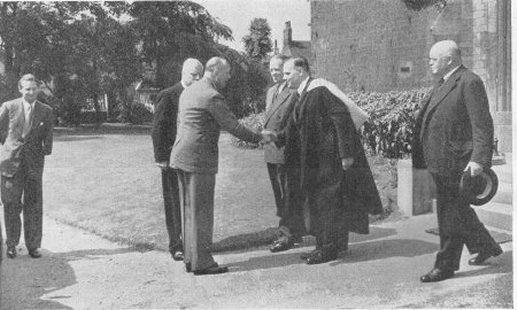 |
"Meanwhile, on the school field, all was set for the presence of
the Royal Party; and a large crowd of boys, parents, masters and
friends was assembled before the open-air setting of the pageant
play, especially written for the occasion by Mr Bartley.
The pageant was at once extremely successful and it was
clearly enjoyed throughout by the spectators. With the trees
forming a picturescue background setting for the historical scenes
and brilliantly-coloured Tudor costumes of the players, the spectators
saw unrolled before them stirring episodes in the very early
history of the school. The scene was full of gaiety, and indeed
one which should linger in the minds of the members of the school
for a very long time".
Retfordian, July 1952, page 2
|
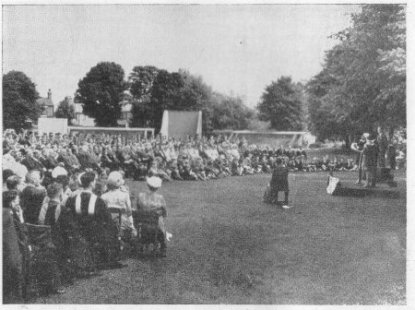 |
12. Mock Election
An event less publicised occured on 19 Oct 1951. I was a new
boy that year, so was the Headmaster John Gover, and in his innocence
he decided to hold a Mock Election. Candidates from Conservative, Liberal,
Labour and Communist parties were chosen from the prefects, speeches
were made and canvassing allowed. Half the boys in the school were
from a background that naturally voted for the Right, and the other half,
from mining families who voted for Labour. The two did not like each other.
Very soon, gangs developed who
went round threatening to beat up anyone who voted against them. This was
especially hard on the new boys, who got beaten up without pretext anyway.
A description of the event is given in the Retfordian for December 1951,
from an adults point of view. From an 11 year old boy's viewpoint, I can
tell a darker story.
.....Election meetings were held mainly by the Labour and Conservative
parties. Lee, wearing a cloth cap and red muffler, addressed a howling mob
from the door of the projection room, whilst Stannard spoke from a small
window in his committee room at the back of the Hall. Among the most
regular members of his audience was the Communist candidate who carried a
long pole at the top of which was a placard bearing the word "Peace"
......It should be added as footnote, that the Communist
candidate forfeited his sixpence deposit, which was used by the Returning Officer to pay for rubber bands,
string and sealing wax.
|
The result was: Con 159, Soc 117, Lib 46, Com 7.
Interestingly, 6 days later a General Election had similar results:
Con 321, Soc 295, Lib 25, Com 0. Winston Churchill became Prime Minister
even though he fielded 4.5% less popular vote than Clement Attlee
13. Trains and girls
Apart from walking for the bus every day, there were 2 other ways of
keeping fit that came naturally. Retford was on the main LNER line from
London to Edinburgh, a perfect place for train-spotting to which I was
addicted until the age of 13. The snag was from school it was 1,000 yards
through back streets, past the Railway Inn (where a voice often heard singing
was reputed to be McFerran, second master), to the 'spotter's wall',
which had to be covered in 15
minutes in time to see the "1 o'clock pegger" or trialler which left
Doncaster Plant at 1 o'clock and reached Retford around 1:20
It was an ex-works loco and was our best chance of seeing a rare
Scottish pacific. Richard Allsopp writes:"I have attached a photo
of it at Retford on this occasion a K3. Note the special lamp carried
to show that it was from the plant."
After a heavy talking-to by my parents because I was
not doing well enough in exams, I gave up train spotting just as hormones
kicked in and changed my interests anyway to young ladies at the High School.
Unfortunately this was also 1,000 yards away, along the canal towpath. The
towpath was on
the opposite side from the field behind the High School;
20 yards of deep
water separated us from the objects of our desires, perhaps a good thing
for an overpopulated planet.
14. Chemistry lab
When I left in 1958, the chemy lab had hardly changed at all since this
picture was taken in 1917
...but the boy's fashions had changed considerably. It was a long room
squeezed between the Art Room, the Gymn, the Senior cloakroom and the
front bike sheds. Rows of glass capped bottles on the bench shelves
held evil liquids, the elegant fume cupboard at the far end of the
room was the source of the worst smells.
All the liquids eventually got washed down the sink, heaven knows what
the sewers looked like.
Nobody wore eye protection but I don't remember any accidents.
The gas lighting had been changed to fluorescent by 1951.
Out of camera, to the left, was the master's desk and blackboard, and
entry to the lockable store room,
where the most interesting chemicals were kept.
Bunsen burners with rubber piping heated flasks on gauzes on tripods.
As I took 'S' level chemistry I spent hundreds of hours in this lab,
my worst injury being when I grabbed
a still-hot tripod and was sent to the local chemist's shop for vaseline.
Here I manufactured Nitrogen Iodide (NI3), a sharp detonator,
and sold it to the kids.
I was in the process of making Methyl Mercaptan (CH3SH)
which I found described in a textbook as "the worst smell in the world".
The master (Taffy Jones) looked over my shoulder, realised what I was
doing, and carefully took the test-tube out of my hands saying
"I wouldn't do that if I were you". I mentioned this event when I saw him
40 years later, he remembered it.
15. Canteen
Hot dinners were served in the canteen, two courses and two sittings,
one shilling per day. Dinner money of five shillings was collected on
Fridays when the Register was taken first thing in the morning. Very few
boys did not use the canteen. It was a prefabricated building of mid-1940s
vintage, full of tables and chairs, with a high table for a few masters.
Behind were kitchens where the food was heated up again. Large metal
containers were brought by van about noon to the school and transferred
quickly to the kitchen, where stout ladies in white coats heaved them
into gas-powered ovens. When warm enough they were brought to a serving hatch.
Meantime hundreds of salivating boys lined up by form under prefect control,
and filed in to the tables on a signal from one of the stout ladies.
When the containers were opened, immense A-bomb clouds of steam rose to the
ceiling, amidst groans of "sprouts again". Vegetables were placed in tureens
carried to a table by an appointed table-servant, boys queued for meat and
seconds, and a sweet. Personally I found all the food good and tasty, a problem
that has followed me for the next 60 years. However, many boys found that peas
made excellent projectiles when propelled by a metal table knife while the
table prefect wasn't looking. Finally, used plates were taken back to the
hatch, and boys filed out to make way for the second sitting. Alas, I believe
that the canteen with its good, wholesome balanced food vanished shortly
after I left school, to be replaced by lunch boxes, sandwiches and canned
drink dispensing machines. All that can be said against the canteen is that
it blocked a fine view of the cloisters built 100 years earlier.
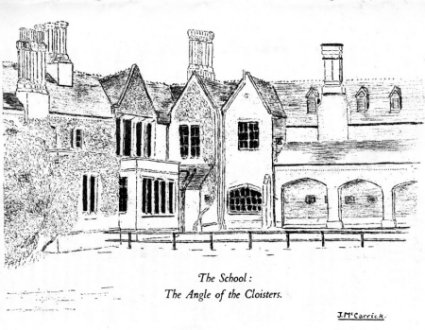 |
16.
School uniform
Uniform was green blazer and grey trousers (short or long according to age)
and red/green cap. Blazers had red piping and it was painfully obvious who
were
new boys, their blazers and caps were unmarked. Wise new boys rolled in
the dirt before starting school, innocent new boys were rolled by older
boys, and had their caps stamped on for good measure. That was the first
lesson at Grammar School. Senior boys looked scruffy, had long trousers,
and wore their caps at a jaunty angle. Prefects were allowed blazers
without piping and had all-green caps with a tassel dangling down (I
still have both my caps in fair condition, wouldn't sell them for the world).
circa 1951
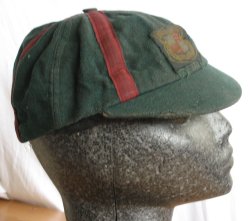 |
Junior cap and jacket badge from 1951
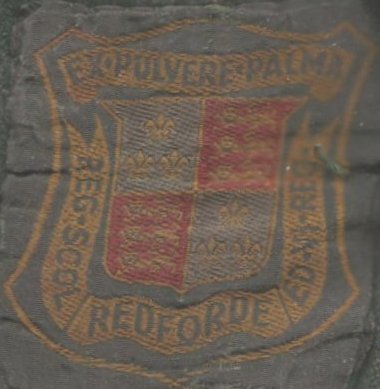 |
circa 1957
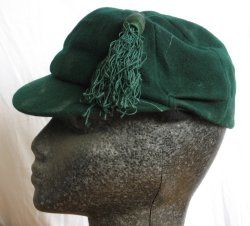 |
EX.PULVERE.PALMA
REG.SCOL | REDFORDE | ED.VI.REG.
|
Boys
seen out of school without caps were usually punished by prefects giving
them "lines". Most boys had "short back and sides" haircuts, but unusual
styles were just getting started in the mid 1950's. Our Head boy 'Daz'
had a D.A. style, I always assumed it was named after him, D.A.Smith
17. Games and Athletics
The large field came into its own with Athletics. It had room for a 440
yard track, a 100 yard track, jumping pit and space for shot, high jump,
and even (with care) javelin. Throwing the cricket ball was banned before,
the war, pity, as cricket ball and javelin were my best events (100+ yards
and 151 feet). Standard Tests were a good idea, where each boy had to
do his best at a large number of Athletic events, score points against
a standard for his age, and his school house gained a total for all
boys who could be caught and 'persuaded' by an enthusiastic Athletics
captain. When Athletics captain my house Gough won the Standard Tests,
and my powers of persuasion learned then stood me in good stead over my
working life.
In the centre of the field was a cricket pitch, only used after school
or weekends
for important matches.
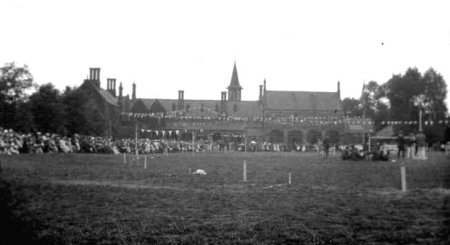 |
We were a soccer, not a rugby school, and for these
large scale team games we had to walk 800 yards to Grove, where there were
2 football pitches, a cricket, and changing rooms. The pitches were bumpy,
angled and next to the Sheffield-Lincoln railway line, but I learned the
rudiments of these hallowed games, while keeping an eye open for
interesting steam locos. When wet, we had to resort to a rather
ridiculous game called crab-football indoors in the Gymnasium, where we
also did P.T. In 1957 two squash courts were built at school,
I'd never heard of the game but learned quickly and played to good club
standard for the next 33 years. Squash was ideal for those free periods
in the 6th form if you could find an opponent of your standard. I did,
and have much to thank Lionel Jones for. At the start of each year came the
Cross Country. Maybe 120 boys set off in mud and cold, most finished the
course of 3 miles I think. I only took part once, coming 117th, it was sheer
hell and I have no desire to think more deeply about it...At the bottom
of the field a fives court was built around 1925. This was a brutal game,
played with a bare fist and not many people used it in my day. My best
memories of it are throwing a cricket ball that cleared the 100 yard track
and went first bounce into the fives court, making two players forget their
game for a moment.
18. Library
There was a small Library at the West end of the New Block, top floor.
However it stocked some most interesting books, and boys could branch
out to use the Denman library in the middle of town (about 900 yards).
Here I discovered my interest in Relativity and Vegetable Poisons,
which I keep to this day.
19. Founder's Day
Each year, near the end of the Autumn term, a service was held in
East Retford Parish Church (St.Swithun's) to celebrate the Foundation
of the school.
Packed with boys, masters, important locals and old boys, the sermons
were boring but many of the hymns stirring. But the chief spectacle was
to see the whole school walk in a great crocodile over the canal, into
the Market Square, round the corner into Canon Square and the church
(again about 1,000 yards). Boys were encouraged to be smart, masters
wore their gowns and silks and mortarboards,
a powerful memory even after
60 years, maybe I'm a sucker for spectacle. Afterwards we were allowed
to go home, and I headed for the Worksop bus a few yards away.
20. Getting home
The single-decker bus back to Worksop was due at the Albert Road stop
at 3.45pm.
School ended at 3.50pm. This meant we had to go from desk to bus stop
faster than light so we could go back in time. It was a problem that would
have puzzled Einstein, but we managed to solve it 4 days out of 5.
Richard Allsopp (a schoolmate and good friend) writes:
"....Later as a schoolboy attending King Edward VI school in the 1950s
I could not help thinking that the school provided something of a headache for
both East Midland and Sheffield operations. In the morning two double deck
buses were provided by Sheffield for Worksop pupils attending the girls
and boys schools in Retford (no co-ed in those days). In addition a single
decker bus provided the Gainsborough service and ran some 5 min later
to avoid getting involved with the school run. Needless to say the pupils
and the grammar schools art master discovered that they could have an extra
5 min in bed and still get to school on time so the Gainsborough bus was
often full and standing while the double deckers were often half empty!
The return journey was even more difficult owing to the grammar school's
insistence on finishing at 1550. Sheffield provided one double decker for
the schools supplemented by the return Gainsborough bus. Only one double
decker was deemed necessary as it was due at the grammar school stop in
Albert Road at 1550 and the boys would not be out in time to catch it.
All very well, but the reality was somewhat different and the traffic
conditions ensured that, as a rule, it was late and at least half the boys
ran across the A1 to catch it, risking life and limb in the process. When the
bus reached the girls school on such occasions it was often full and they
got left behind. The grammar school did everything, except vary their own
finishing time, including asking the bus company to alter their timings
and instructing masters and prefects to take the names of anyone attempting
to catch the bus by standing at the stop. This was short lived as on such
occasions there were floods of complaints from the public and East Midland
who had to deal with the resultant crowd on their 1615 service from
Cannon Square for which one double decker was provided.
Usually an East Midland inspector appeared and assessed the situation, no
doubt summoned by the bus crew from the cafes across the road! If it called
for a duplicate vehicle one of the oldest vehicles available would soon
be seen making its way from Moorgate depot round the corner.
I recall on one such occasion an ex-Yorkshire Woollen District Leyland
N104 turned up. The inspector enticed us off the double decker with the
promise of a non-stop run to Worksop. Unfortunately, on take-off, the
driver stalled the bus and flattened the battery trying to start it again.
The rather red-faced inspector set off for the depot on foot (no mobile
phones then) to get a mechanic. We boys decided to get back on the service
bus fearing that it would set off before things were resolved. However
some of the senior boys went to the driver and offered to bump start
the bus which he readily agreed to (no health and safety to worry about
then). By this method the problem was resolved, we piled on again and off
we went. I often wonder what the inspector said on his return! It would
have made a good sketch for "On the Buses".
|
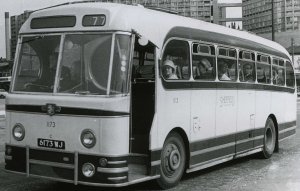 |
Once a boy nearly got killed running across the main road to catch this bus.
We were forbidden to even try, and a prefect was stationed at the bus stop
to check. Once McFerran himself was at the bus-stop, I heard someone shout
"Mac" and we all turned and ran the other way! When
we missed it we had another 1,000 yard walk to Cannon Square to catch the
4.15 bus (the square has a cannon dating from the Crimean war)
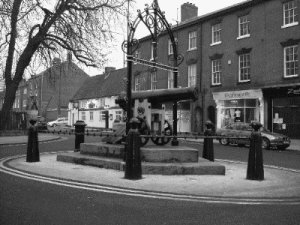 |
The early bus was caught by the school girls further along the
route, giving us even more incentive to become time-travellers. Both buses
passed the senior girls playing field, and we were all agog to see who was
getting on. I only had eyes for Christine or June, but enough said. As we
entered Worksop we stopped at Manton Pit, where many tough miners would get
on, carrying lunch boxes and with faces still covered in coal dust,
even though
pit head baths had been installed recently. I heard that their wives would
scrub
their backs in a tin bath in front of the fire, part of their culture.
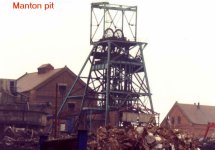 |
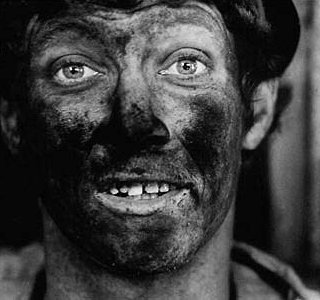 |
Then
a 1,000 yard walk back home with a couple of boys who lived nearby, where
with luck a meal was waiting for me. Between 6 and 8 I did prep on a desk
in my bedroom, pretty important in later years, after which I could watch
a bit of TV (my favourite was Quatermass Experiment)
before going
to bed about 9pm. A good nine hours sleep before
the start of another day. With all that walking, eating and sleeping,
no wonder my health was fairly good. Those were the days!
21. Exams
In February 1955 we had a "mock Certificate" to prepare for the 7 subjects
we were to take for G.C.E 'O' Level in July. I worked very hard and
excelled myself, coming top out of 92 boys in 5A, 5B and 5J. At Speech day
I got 2 prizes (books I still have) and got nice words from the Head and
my parents. Since this was the summit of my academic career (although far
from the end), 55 years ago and for the first time, I will publish a scan
of a page from my diary, see exam results. Things were
never to be so easy in the next 50 years!
22. Conclusions
Writing this page has made me realise several things. How the end product
(an educated 18 year old) depended on many people doing their
jobs properly. Masters, bus drivers, canteen workers, cleaners,
tax collecters and the wealth generating working community. My Aunt and Uncle,
who supplied a stable and secure home and (boys have to whisper it)
- love. How the way of life described has disappeared, only now existing
in my memory (and online). And how I am now living in the Dan Dare
future - there are
so many technical things I would love to tell my Physics masters Dunc and Bo,
I do hope I meet them again. To all these people, my heartfelt thanks for a
vivid and successful 10% of my life.
|
|
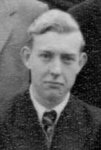
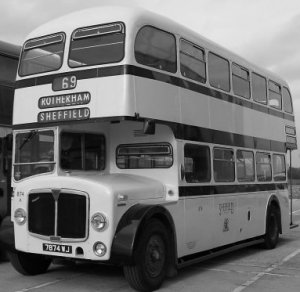


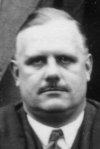
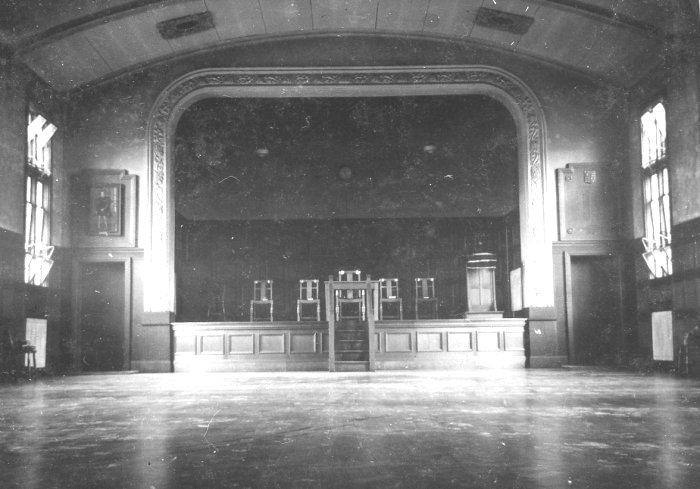

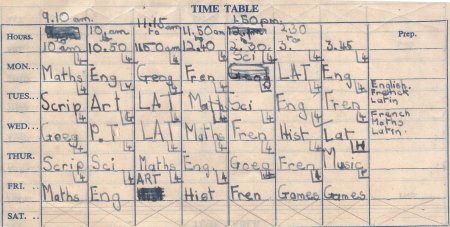
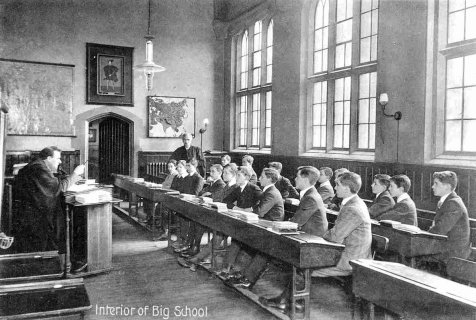
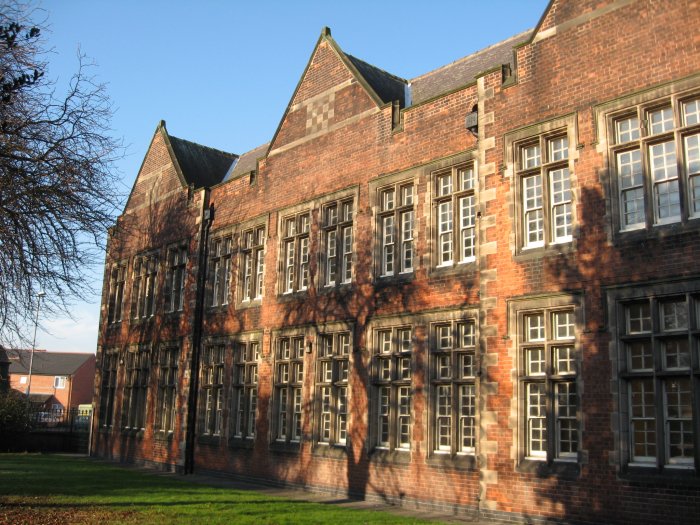
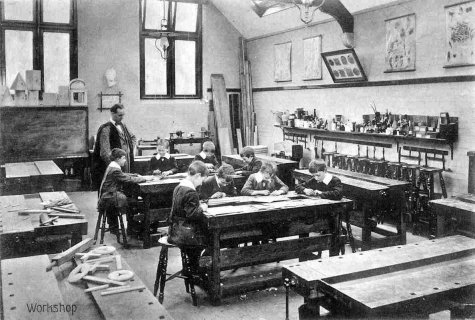
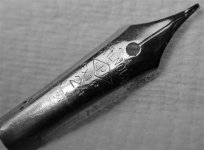

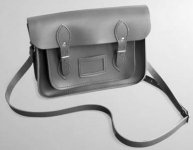
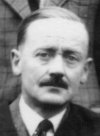
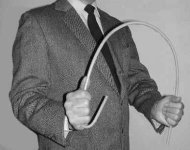
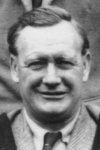


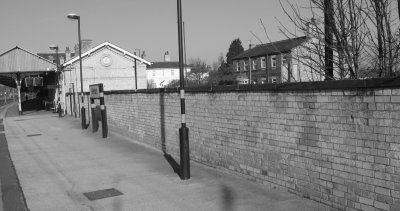

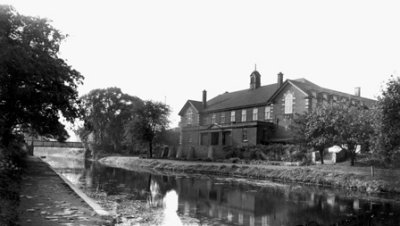
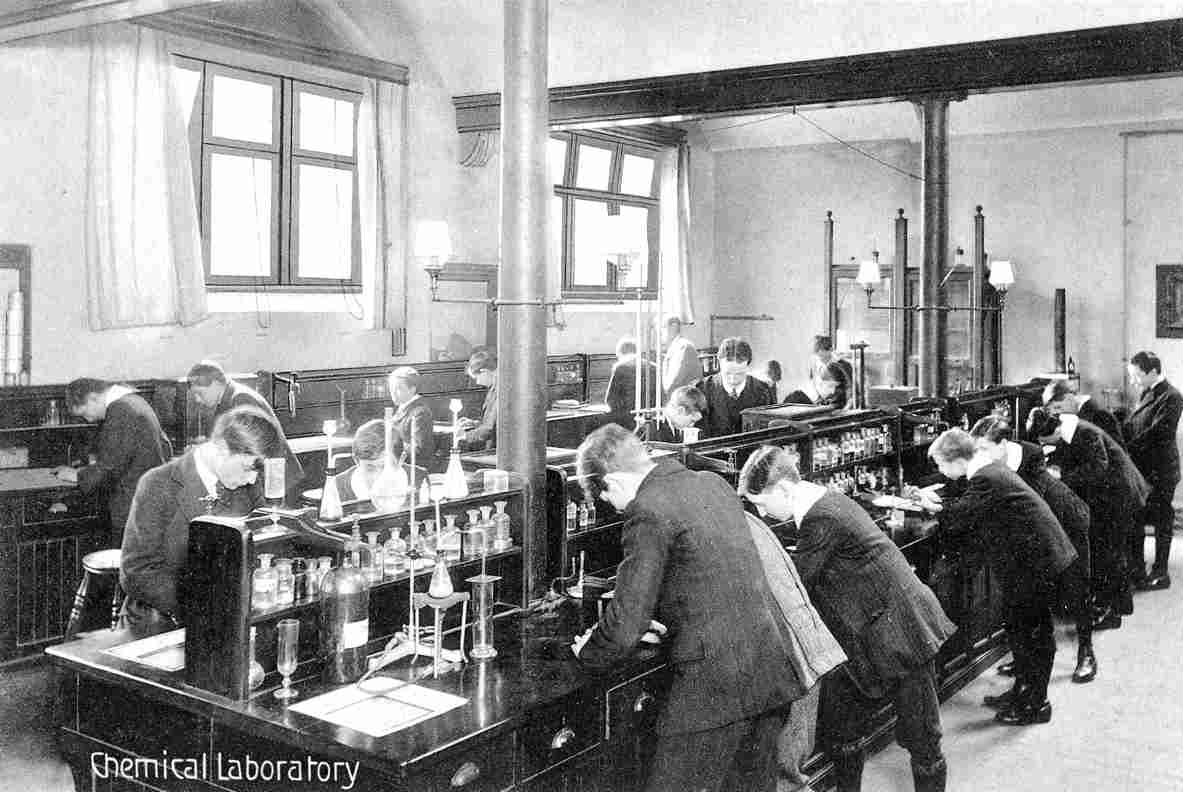




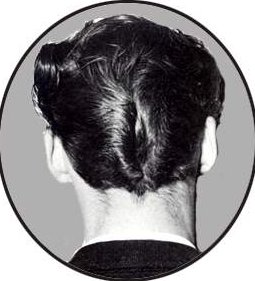

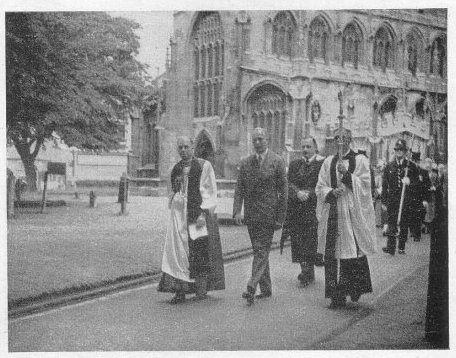
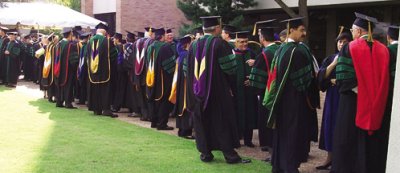




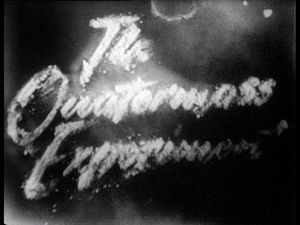
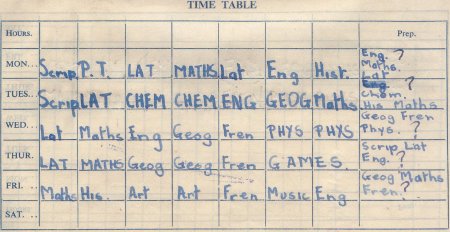
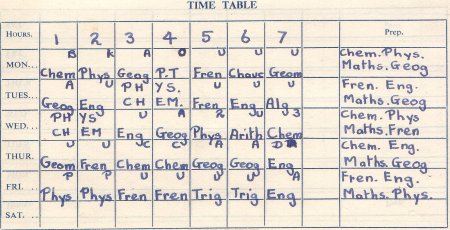
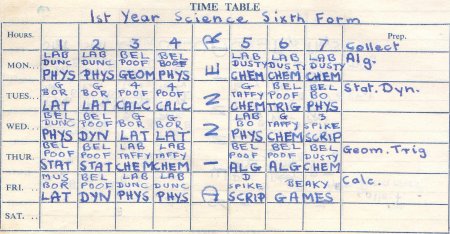
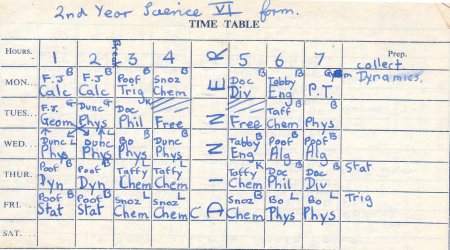
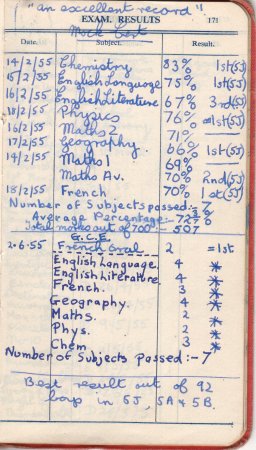
 All Rights Reserved.
All Rights Reserved.